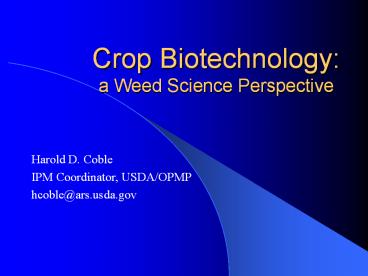Crop Biotechnology: a Weed Science Perspective - PowerPoint PPT Presentation
1 / 24
Title:
Crop Biotechnology: a Weed Science Perspective
Description:
Reared on small diversified farm in 1940s-50s. Very familiar with the drudgery of hand hoeing ... Photo Craig Chism, Univ. of TN. What's the Downside? PIPs ... – PowerPoint PPT presentation
Number of Views:49
Avg rating:3.0/5.0
Title: Crop Biotechnology: a Weed Science Perspective
1
Crop Biotechnologya Weed Science Perspective
- Harold D. Coble
- IPM Coordinator, USDA/OPMP
- hcoble_at_ars.usda.gov
2
My Perspective
- Reared on small diversified farm in 1940s-50s
- Very familiar with the drudgery of hand hoeing
- College degrees in agronomy weed science
- Weed science extension research for 30 yrs
- Always been a farmer at heart
- A proponent of IPM USDA IPM Coordinator
3
And, for many reasons, I believe in
conserving our natural resources
Photo credit USDA/NRCS
4
Pest management is all about crop yield and
quality preservation and ease of harvest.
Photo credit USDA/NRCS
5
Pest Management StrategiesThe PAMS Approach
- Prevention
- Cultural practices to keep pests out
- Avoidance
- Cultural practices to avoid or resist pest impact
- Monitoring
- What is present and how many
- Suppression
- Kill em if you need to
6
Pest Suppression Options
- Physical
- Hand Weeding
- Mechanical Cultivation
- Other (mulches, , traps, etc.)
- Biological
- Insects, Bacteria, Fungi, Biochemicals
- Chemical
- Chemical Pesticides
- Pheromones
7
Chemical Weed Control
- Historical non-selective chemicals (NaCl)
- Key to chemical use is selectivity
- Development of 2,4-D in 1940s
- Research programs for selective herbicides
- Rapid expansion of chemical use in 1960s 70s
- 100 major crop acreage treated today
8
Attaining Selectivity
- Massive chemical screening programs
- Selection in crop breeding programs
- Tracy soybean
- Non-transgenic methods
- Sethoxydim-tolerant corn (tissue culture)
- STS soybean
- Transgenic technologies (Biotech)
9
Growth of Biotech Acres of Total U.S. Acres
10
Biotech Crop Uses
of Acres
11
Western Corn Rootworm Adult
Photo credit USDA/ARS
12
Why the Rapid Adoption?Herbicide Tolerant Crops
- Lower cost of weed control, even with technology
fees - Greatly simplified control procedures
- Higher degree of weed control
- Fewer chemical applications less trips
- Promotes more sustainable cultural practices
- Less tillage, less compaction, narrower rows
- Societal aspects (pride, landowner acceptance)
13
Higher degree of control at lower cost
Photo credit USDA/NRCS
14
And prevent disasters such as this
Photo credit USDA/NRCS
15
Why the Rapid Expansion?Insect Protection (PIPs)
- High degree of control of target species
- Safety to beneficial species
- Human and environmental safety
- Food/Feed safety
- Applicator safety
- Wildlife safety
- Simplicity of control measures
16
PIPs aimed at the major insect pest complexes
Photo credit USDA/ARS
17
Plant-incorporated protectants designed to
avoid harm to beneficials
Photo credit USDA/ARS
18
Whats the Downside?Herbicide Tolerant Crops
- Weed species shifts if integrated approach not
used - Prevention and avoidance strategies
- Continued field monitoring
- Alternative chemical mode of action
- Reduced availability of alternative MOAs
- Temptation to just plant and spray
19
Weed resistance is a fact of life
Photo Craig Chism, Univ. of TN
20
Whats the Downside?PIPs
- Risk of resistance development/selection
- Major concern of organic community
- Increased cost if populations below EIL
- Protection present whether needed or not
- Have led to secondary pest resurgence
- Stinkbugs in cotton
21
Tarnished Plant Bug
Photo credit USDA/ARS
22
Where do we go from here?
Tacos, Chicken feed, or Plastic??
Photo credit USDA/NRCS
23
Meat, Milk, or Pharmaceuticals???
Photo credit USDA/NRCS
24
Weve only just begun
Photo credit USDA/NRCS































